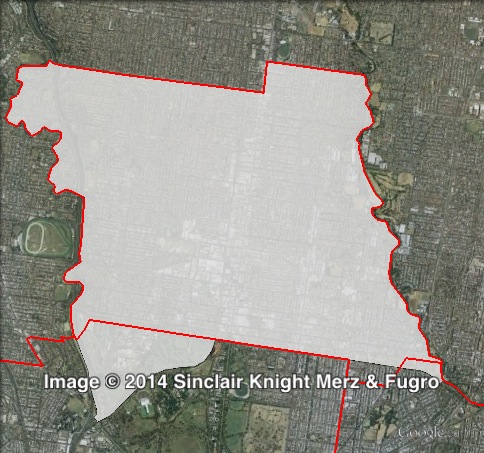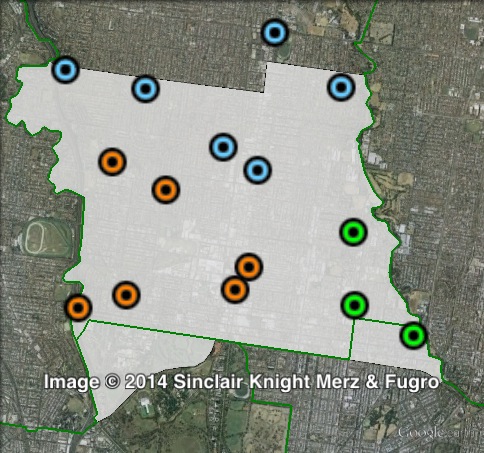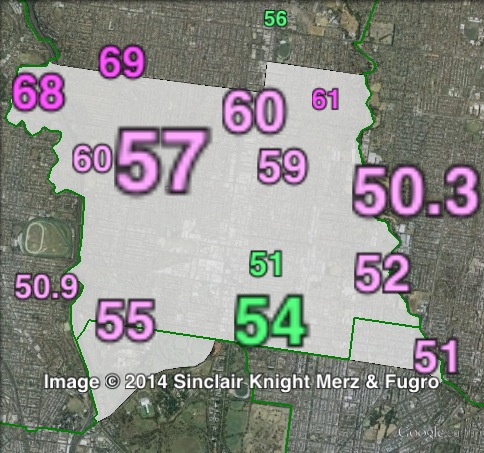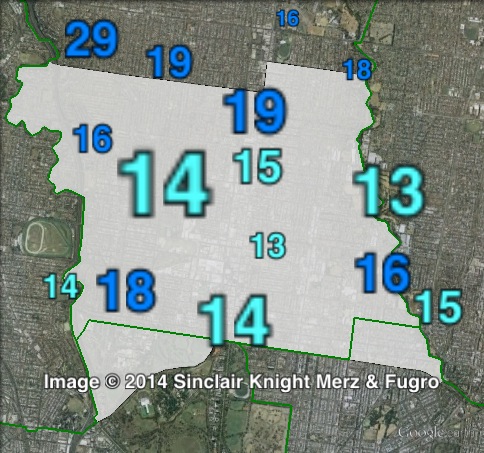ALP 3.6% vs GRN
Incumbent MP
Jane Garrett, since 2010.
Geography
Inner north of Melbourne. Brunswick covers the suburbs of Brunswick, Brunswick East, Brunswick West and parts of Coburg, Fitzroy North and Parkville. Brunswick covers southern parts of the City of Moreland, and small parts of the City of Melbourne.

Redistribution
No changes were made to Brunswick’s eastern, northern or western boundaries. Brunswick’s southern boundaries were slightly changed, gaining some areas from Melbourne. The border with Richmond in the Fitzroy North area was also realigned along Park Street.
History
There has been a state electorate of Brunswick at three different periods in Victorian history. The seat first existed from 1904 to 1955, when it was won at every election by the ALP, before sitting member Peter Randles was expelled from the ALP in 1955 as part of the DLP split.
The seat was re-created in 1976. It was won by the ALP’s Tom Roper, who had previously held the seat of Brunswick West since 1973. Roper served as a minister in the Labor government from 1982 to 1992. At the 1992 election, the Labor government was defeated, and Roper moved to the new seat of Coburg, with Brunswick being abolished. He resigned in 1994, and succeeded in Coburg by the ALP’s Carlo Carli.
In 2002, Coburg was again replaced by the seat of Brunswick, and Carli moved to the new seat. He was re-elected to the seat in 2006.
Carlo Carli retired in 2010. The ALP ran Jane Garrett.
The Liberal Party had preferenced the Greens in 2002 and 2006, but in 2010 the Liberal Party decided to preference the ALP ahead of the Greens. This resulted in Labor’s Jane Garrett winning the seat, despite suffering a negative swing of almost 12%. If the Liberal Party had repeated their previous practice of preferencing the Greens, then the Greens would have won. Instead, the Greens narrowed the margin by 0.13% despite losing a large chunk of preferences.
Candidates
- Tim Read (Greens)
- Ward Young (Animal Justice)
- Frank Giurleo (Family First)
- Jane Garrett (Labor)
- Dean O’Callaghan (Independent)
- Giuseppe Vellotti (Liberal)
- Stella Kariofyllidis (People Power)
- Babar Peters (Australian Christians)
Assessment
Brunswick was an unusual result in 2010 – there was a collapse in the Labor vote, most of which flowed to left-wing independent Phil Cleary. Cleary’s preferences overwhelmingly favoured the Greens, who were leading after Cleary’s preferences were distributed. But the Liberal preferences – which were the only reason why the Greens had been competitive in 2002 and 2006 – saved the day for Labor, flowing to Labor and giving them a 3.3% margin of victory.
Liberal preferences remain the decisive factor in Brunswick – if they were to preference the Greens, it would almost certainly result in a Greens victory. The more likely outcome is that the Liberal Party will again preference Labor, as they did in the 2013 federal election.
Assuming that the Liberal Party chooses to preference Labor over the Greens, the Greens would need to gain a further 3.3% swing on top of the swing against Labor in 2010. In 2010, Labor was lacking a sitting MP with a personal vote, while in 2014 you would expect some personal vote for Jane Garrett. These factors will make it hard for the Greens to win.
2010 election result
| Candidate | Party | Votes | % | Swing | Redist |
| Jane Garrett | Labor | 13,129 | 36.02 | -11.74 | 35.98 |
| Cyndi Dawes | Greens | 11,023 | 30.24 | +0.53 | 30.55 |
| Kyle Dadleh | Liberal | 6,209 | 17.04 | -0.38 | 17.00 |
| Phil Cleary | Independent | 3,914 | 10.74 | +10.74 | 10.41 |
| Amy Mulcahy | Sex Party | 1,418 | 3.89 | +3.89 | 3.94 |
| Trent Hawkins | Socialist Alliance | 405 | 1.11 | -0.93 | 1.12 |
| Bill Cawte | Independent | 348 | 0.95 | +0.95 | 0.95 |
| Other independents | 0.06 |
2010 two-party-preferred result
| Candidate | Party | Votes | % | Swing | Redist |
| Jane Garrett | Labor | 19,411 | 53.26 | -0.37 | 53.60 |
| Cyndi Dawes | Greens | 17,033 | 46.74 | +0.37 | 46.40 |

Booth breakdown
Booths in Brunswick have been split into three areas: East, North and West.
The ALP won a majority of the two-candidate-preferred vote (Labor vs Greens) in all three areas, ranging from 51.1% in the east to 62.3% in the north.
The Liberal Party came third, with a vote ranging from 14.3% in the east to 20.1% in the north.
| Voter group | LIB % | ALP 2CP % | Total | % of votes |
| West | 14.72 | 53.24 | 10,167 | 28.95 |
| North | 20.06 | 62.28 | 7,609 | 21.67 |
| East | 14.26 | 51.13 | 5,356 | 15.25 |
| Other votes | 18.22 | 48.74 | 11,983 | 34.13 |




Cleary in the last election makes this difficult to read. I would suggest that Cleary voters have probably been in the electorate longer than most and remember him from his days as the Wills MP – and that by extension his running last time probably funnelled preferences to the Greens that they may otherwise not have got.
Until Labor definitively said they’ll stop the East-West Link, I thought this was in play. I reckon Jane Garrett (who is a real star of the inner-city left) should hold fairly safely now.
Opinion polls show the Greens consistently well above 11% of the vote statewide, which is the percentage of the vote they achieved at the 2010 state election, in Victoria throughout the last four years.
I think the Greens will be wanting to nail this and Melbourne down, and will no doubt put a lot of effort into their campaign in an attempt to turn the two seats green.
Brunswick and Melbourne (state) fall almost entirely within the federal Division of Melbourne, where Adam Bandt won the seat pretty much in his own right at the 2013 federal election, without having to rely on preference flows from the Liberal Party. It is definitely within reach for the Greens to win this and Melbourne in 2014, even if the Liberal Party indicate a preference for Labor ahead of the Greens.
Brunswick is in the federal seat of Wills, not Melbourne. Federal Melbourne is made up basically of the state seats of Melbourne and Richmond.
The problem the Greens have in the state seat of Melbourne is the strong Liberal vote in the CBD, Docklands, and East Melbourne. This makes it harder for the Greens to get far enough ahead to overcome the Liberals preferencing Labor. In the federal seat of Melbourne, that’s not a problem, because it also takes in all the strong Green areas around Fitzroy and Collingwood (in the state seat of Richmond), where the Liberals do very poorly.
Brunswick is an easier task for the Greens, because the Liberals have no presence there, and demographic change is strongly favouring them. I expect them to do very well here.
I don’t think labor being in opposition will help there cause in taking seats also the fact that the general trend appears to be a swing to labor wheas the state and federal results where swigs against labor being the trend and mood. Sophomore sure will help labor and I think the mood in these progressive seats will be a desire to see a labor government so that won’t work for a protest that well.
There one chance was the Melbourne by-election and they blew it so sorta hard to see a situation where the greens would be competitive in these seats